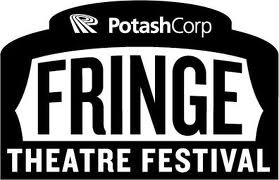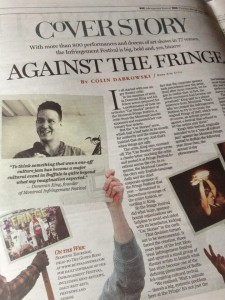World Fringe Congress to welcome infringement festival
The Montreal infringement festival, sometimes described as “the anti-Fringe”, has been invited to the first-ever World Fringe Congress, a gathering of the leaders of 40 Fringe Festivals – and one infringement festival – from 13 countries across the globe.
The Edinburgh Fringe Festival, now the largest arts festival in the world, will be hosting the unique event this year from August 16 – 19, 2012. Set during the Fringe in Edinburgh, Scotland, the purpose of the Congress is “to create a lasting network and a real sense of how Fringes can work together to achieve all our aims”.
The Edinburgh Fringe Festival has humble, yet controversial beginnings in 1947. It all started on the heels of World War II, when a group of local Scottish artists were snubbed by a new festival called the Edinburgh International Festival that refused them permission to play there. In retaliation, the artists played on the “fringe” of the elitist festival, a term that was officialised the following year (1948) after journalist Robert Kemp wrote: “Round the fringe of official Festival drama, there seems to be more private enterprise than before … I am afraid some of us are not going to be at home during the evenings!”
What began as an artistic protest against elitism and exclusion soon blossomed into a global movement, with Fringe becoming an artistic genre that signified true independence: edgy, Do-It-Yourself performances that challenge the status quo, often through bold irreverence, experimentation, and controversy.
Not only did the Edinburgh Fringe eventually grow much bigger than the original elitist festival, but the movement also spread to many other countries, where Fringe Festivals sprouted up to meet the cultural and activist needs of various communities around the world.
The Fringe concept became especially popular in Canada, with the first festival appearing in 1982 in Edmonton. By the early 1990s, over a dozen Canadian Fringe Festivals had come into existence and organizers began meeting to find ways to consolidate the artistic movement. On September 26, 1994, they founded the Canadian Association of Fringe Festivals (CAFF) , allegedly to to “safeguard the integrity of Fringe Festivals”, amongst other noble-sounding objectives.
In 1998, the CAFF trademarked the word “Fringe”, allegedly to “preserve…“Fringe” ideals and principles,” however, according to the Canadian Intellectual Property Office, CAFF actually trademarked it for financial purposes, including the selling of Fringe-related wares and services:
WARES: (1) T-shirts, caps, brochures, programs, posters and mugs. (2) Bookmarks, calendars, decals, collectible cards, greeting cards, notepads, diaries, pens, glasses, mugs, tumblers, memo pads, key chains, bumper stickers, adult and children’s clothing, – namely shirts, pants, woven shirts, polo shirts, fleece shirts, sweaters, tank tops, sweat pants, shorts, scarves, hats, caps and sun visors, umbrellas, hand held fans and cushions.
SERVICES: (1) Presentation, the advertisement and the promotion of theatre productions.
Unfringe-like? It gets worse. Canadian Fringe Festivals and the CAFF also frequently threaten legal action against students and independent artists who attempt to use the word “Fringe” without their permission. Furthermore, Fringe artists have been complaining for over a decade about the unfair treatment they receive at CAFF-sponsored Fringe Festivals, including everything from excessive fees to play, censorship, conflict-of-interest sponsors, corporate spam visually polluting Fringe sites, the expulsion of artists from the Fringe for criticizing sponsors, and even the banning of political artists and physical aggression by Fringe security guards. Worse still, some of the Canadian Fringe Festivals have even sold naming rights to questionable corporations.
For example, the Saskatoon Fringe was recently renamed the “PotashCorp Fringe” after a $40 Billion corporation that extracts natural resources to make fertilizer. The industrial process causes untold environmental destruction, and PotashCorp has been criticised for damaging ecosystems and importing minerals from the illegally occupied Western Sahara. Meanwhile, the Montreal Fringe Festival is named after St. Ambroise beer, and there is speculation that the Toronto Fringe Festival will soon be named after the TD Bank, following a series of close collaborations between Fringe administrators and bankers.
Needlees to say, the corporate takeover of the Canadian Fringe Festivals has resulted in angry artists petitioning for the festivals to protect the original Fringe concept and return to its activist and community-based roots. The media is taking note of the brand damage too, with Montreal Gazette editor Lucinda Chodan noting:
“I was here in Edmonton when the first Fringe was launched. I’ve followed it through the years, and frankly, the Fringe in general has become more mainstream, sometimes just plain silly. The edge isn’t there anymore.”
Meanwhile, in Edinburgh, Fringe veterans are complaining about similar issues of corporate manipulation, with journalist and performer Stewart Lee describing the situation as the “slow death of the Edinburgh Fringe”.
Likewise, Deborah Pearson, a Torontonian who moved to Britain in 2005, has been very successful overseas with a performance collective known as the Forest Fringe. In 2007, she founded a venue by that name at the Edinburgh Fringe – as a “totally independent, not-for-profit space.” In 2010, Stage magazine listed her and her artistic partner Andy Field as two of the 100 most influential people in U.K. theatre. Ironically, in Canada, Forest Fringe would be illegal and subject to lawsuits due to trademark infringement. In Canada, Deborah Pearson’s success would have been blocked by corporate interests.
Like it or not, with all the corporate influence and interference, the Fringe Festival certainly isn’t what it used to be.
Enter The World Fringe Congress, and event organized by the World Festival Network. This organization “acts as a liaison between festivals and implements cross-festival ideas and relations, such as award schemes, tours and funding opportunities.” They also offer “consultancy, start up and advice to new festivals.” Both organizations were founded by Holly Payton, an arts administrator with plenty of experience at the UK Fringes. According to her profile:
“Holly has worked in the festival business since 2001, rebranding the ‘Brighton Festival Umbrella’ and founding the Brighton Fringe, which she then managed for 7 years. She has worked as a Festival Venue Director and in the Senior Management Team of Edinburgh Fringe Society as well as for many UK international Festivals.”
When questioned whether the World Fringe Congress would be a good place to debate questions about corporate influence on the Fringe Festivals, especially in Canada, and to discuss the future direction of the Fringe, Payton replied:
“…the Congress will recognise that there are many models of Fringe and many different ideas within it, without recognising any one model, concept or Fringe as more valid than another.”
With 40 Fringes and 1 infringement festival in attendance, it could make for a lively discussion. Despite the fact that CAFF claims 21 Fringe Festivals from Canada and the USA, there are also festivals in countries as diverse as Thailand, New Zealand, Australia, France, Hungary, China, South Africa and Brazil, to name a few. World Fringe provides a list of all Fringe and infringement festivals in the world, including a world map, on its website. Fortunately not all Fringe Festivals follow the corporate model promoted by CAFF, meaning that with no Fringe hegemony or ideological struggle in place, as in Canada, there could potentially be rich discussions amongst the various invitees concerning topics of great concern.
The Fringe in the 21st Century faces a stark choice: the more it allows corporate interference at the festival, the more it damages its value as a Fringe. The choice is whether to allow the Fringe to fade into a mere marketing opportunity for corporations, where artists must pay to become commodities, or whether to put the full power of the Fringe back into the hands of the performers and to empower them, in the spirit of those brave artists who created the Fringe in the first place.
While in Canada the Fringe is firmly locked in a trademark, complete with all its restrictions against artists and following criticism, there is hope the other festivals won’t be led astray down this same destructive path.
Like it or not, the Fringe is a very delicate brand. Corporate interference such as marketing and visual pollution, pay-to-play fees, naming rights, and trademarking are the very antithesis of the original 1947 Fringe. Signifying underground, edgy, artistic, independent, and Do-It-Yourself, the Fringe relies on its own authenticity to succeed. When these slippery corporate concepts are applied at the festivals, it can only damage the Fringe’s image and disempower the artists, which is why a discussion needs to be had amongst stakeholders about where the line should be drawn in regards to our increasingly endangered Fringe.
The infringement festival, created after artists were kicked out of the Montreal Fringe, offers a solution. It has created a mandate designed to empower artists and communities and prevent corporate interference at the Fringe, complete with a guide for seeking ethical sponsors.
The infringement model has proven successful in places as far afield as Ottawa, Toronto, Regina, Nova Scotia and Bordeaux, France, who all staged individual infringement festivals, and in Montreal, Buffalo, Hamilton, and Brooklyn where the festivals are permanent. Buffalo’s 8th edition just enjoyed over 800 performances of “arts under the radar”, making it the largest infringement festival to date.
Furthermore, not only is there strong media coverage about infringement and its history, but there are strong connections between the infringement and newly-formed Occupy movement, demonstrating that progressive politics can indeed take centre stage in the Fringe Arts. People wishing to establish an infringement festival can consult an online Do-It-Yourself Guidebook and receive support from the Global Infringement team.
For those who heed these warnings and are interested in reforming the Fringe, the infringement criteria can be seen as a blueprint to transformation, safeguarding artists while keeping unethical and damaging corporate practices at bay. If the Fringes fail to take this message into account, it could very well be a case of history repeating itself, ironically with the Fringe now cast in the role of the exclusive and elitist festival that it had originally protested against.
If Holly Payton and the World Fringe Congress fully intend “to create a lasting network and a real sense of how Fringes can work together to achieve all our aims”, they need to note that there seems to be two competing aims that are diametrically opposed: one that supports Fringe arts for the original cultural purposes, and one that wants to exploit the Fringe brand for corporate reasons. All Fringes need to decide which of these visions they choose to support, because the two aims cannot be reconciled any more than those of organic farmers and McDonald’s. Simply put, one is grassroots, human, activist and authentic, whereas the other is manipulative, corporate and sometimes even parasitic.
While there is hope the World Fringe Congress can provide a place for the important conversation that needs to take place about the ongoing corporate threats to the Fringe, the danger lies, as always, in corporate manipulation. If those subscribing to the corporate model try and influence, or even co-opt, the more activist Fringe Festivals present at the event, it could very well end up as a mere PR exercise for the corporate Fringe model – and not the urgent debate that needs to take place before even more damage can be done to the cherished and endangered Fringe. The real question that needs to be asked is: where do we draw the line?
With the infringement festival in attendance, represented by myself, Donovan King, at least one voice will be present to argue on behalf of the authentic Fringe, a place where activism and arts take centre stage, and where corporate manipulation and marketing are dismissed and relegated to shopping malls and the like, where they clearly belong. At the authentic Fringe, artists and community must come first.
***
Read more from this series:





